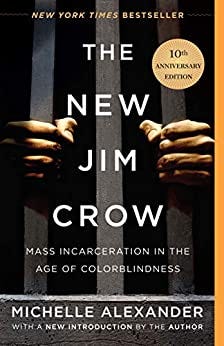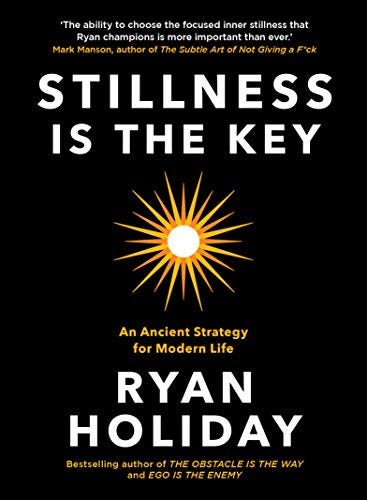#32: The New Jim Crow; Stillness is the Key
It has been over a year since I sent my first newsletter on July 1, 2019. I have sent 30 since then and I love having a record of what I have read. I enjoy going back and recalling what was happening in the world, how I felt about those happenings, and what books I was reading to make sense of the world (or escape from it). Obviously I struggle with consistent documentation and sharing. The past several months since I sent my last letter have been eventful to say the least. I have kept my reading pace strong even though my writing has fallen off. Let's talk about a couple books, shall we?
The New Jim Crow by Michelle Alexander

Yes, I did my prison time. How long are you going to punish me as a result of it?
I remember watching Ava Duvernay's documentary "13th" back in 2017 and not knowing who Michelle Alexander, Bryan Stevenson, or Ibram X. Kendi were. These days those feel like household names. That documentary, viewed at the ripe old age of 33, felt like the beginning of my education in mass incarceration and an unfair criminal justice system. I had always been aware that racial inequality and unfairness existed, but I always thought of it as something that happened "back then." Examples of racial injustice today were rare, I thought. This documentary made me feel like I'd been looking at the issue through the wrong side of binoculars and someone finally flipped them around for me. The issues were suddenly right up in my face, zoomed in, and focused. I was appalled and outraged at the unfairness that was happening right now.
That was 2017. Currently, 2020 is happening. George Floyd was killed in police custody. Breonna Taylor, Rayshard Brooks, Jacob Blake and others were killed or seriously injured by police. Protests and riots have been happening across the country. With the topic of police brutality and racial injustice so prevalent, it was time to further my education.
My book club at work selected to read The New Jim Crow and I'm so glad I read it. It goes even deeper into these issues and was uncomfortable in a positive way. The main argument is that individuals branded "felons" pay for their crime with prison time and then continue to pay through employment and housing discrimination. The majority of those felons are Black men and a significant percentage of the crimes are drug possession. The "war on drugs" of the 80's, Ms. Alexander claims, was actually a war on communities of color.
Ms. Alexander makes many claims. She has an agenda and a bias and judging by some reviews on Goodreads, that agenda and bias upsets some people. What was important for me is that it got me thinking of issues I don't normally think about and I started having several important conversations that I don't normally have. It is painfully obvious that we do have a problem in America and it is bigger and more complicated than I imagined. We have so much work to do and I'm starting in my heart, in my home, and with my vote.
Stillness is the Key by Ryan Holiday

Get your day scheduled. Limit the interruptions. Limit the number of choices you need to make.
Time for some straight talk: I am easily distracted. My wife will tell you to keep me away from shiny things (i.e. book shelves full of books, anything related to movies, a screen of any kind, etc.). While I wouldn't define my life as loud and chaotic, my brain is a bit jumbled most of the time. I rarely sit quietly in a room alone with nothing but my thoughts. And most of the time when I sit down to write, I - Oh! "Grand Designs" is on! Brb...
Needless to say, I had been looking forward to reading Stillness since the beginning of the year so it could solve all my problems (ha, like it's that easy!). I wanted to achieve a stillness of mind, spirit, and body in order to find greater contentment and excellence. A family trip to Bear Lake in June presented the perfect opportunity to dig in and "still out."
Mr. Holiday is a gifted writer and story teller. To support his points, he weaves in anecdotes from the lives of famous people past and present. There were also a multitude of references to Stoic philosophy that reminded me of several stoic principles that I haven't revisited in a while. The book reads more like a hand book that ought to be marked up, dog eared, and referenced when needed. I like that about it, but that's not how I read. I blaze through and then move on to the next thing! Even the book about slowing down and contemplating couldn't get me to slow down and contemplate it. Sigh.
That said, it serves up a lot of advice that you've heard before (keep a journal, meditate, read, get a routine, put the phone down, get enough sleep) but when put all together and sprinkled with stories and Stoicism, feels quite fresh. Reading it was like eating a Monte Cristo for the first time (which I'll never forget was at Kenny & Ziggy's in Houston, TX): Sure I'd had a turkey sandwich before and of course I'd had a ham sandwich before, but I'd never had both stacked between two thick slices of french toast and served with syrup, powdered sugar, and jam! Yum!
For those interested in learning more about Stoic philosophy with modern application, I would highly recommend A Guide to the Good Life by William Irvine.
That's it for me. I've got a few books in the pipeline that I'd like to write about so stay tuned.
Thanks for reading along,
Kyle


